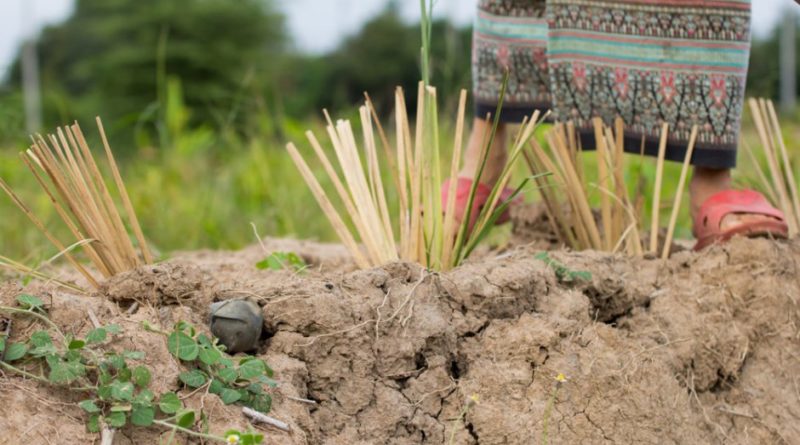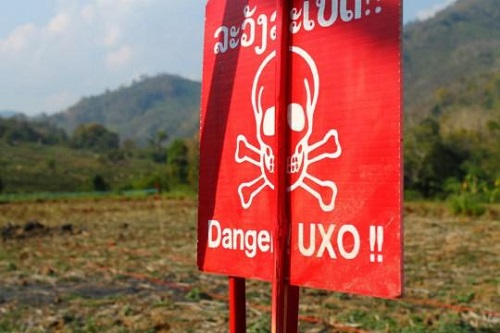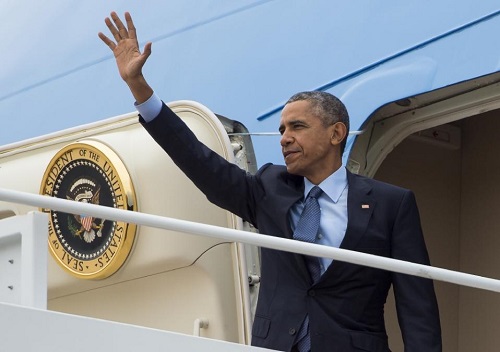Laos: Decades After America’s ‘Secret War’, Unexploded Bombs Still Hinder Development
Source: Asian Correspondent
MORE than four decades after the last bomb fell from the skies above the remote and landlocked Southeast Asian nation of Laos, its countryside remains littered with deadly remnants from a conflict which long-ago faded into distant memory for many in the West.
For the people of Laos however, the harmful impacts of the Vietnam War continue to reverberate deep into the 21st Century.
A covert nine-year US bombing campaign resulted in more than two million tonnes of ordnance being dumped on Laos between 1964 and 1973. This campaign was dubbed the ‘Secret War’, as the raids were conducted without the authorisation of Congress and without the knowledge of the American public. During the onslaught around 30,000 people were killed or injured, and an additional 20,000 civilians have since been maimed by unexploded ordnance (UXO) left behind.

US Air Force ground personnel prepare AIM-7E Sparrow missiles for loading on McDonnell F-4C Phantom II aircraft at an air base in South Vietnam in 1967. It crashed in Laos on 22 March 1968 following a bomb malfunction over Khe Sanh. Source: Flickr / manhhai
In recent years there has been a marked reduction in annual deaths and injuries – from more than 300 in 2008 to less than 50 last year – following an intensification of clearance efforts. However, this must not blur the wider humanitarian legacy of the US bombing campaign: less than 2% of the total contaminated land area has been cleared, in a country which remains amongst the poorest in the region. In short, UXO serves as a major impediment to Laos’ development.
Around 80 million cluster bomblets remain hidden in forests, submerged along river banks and buried in fertile soil. This extensive contamination renders large swathes of agricultural land unusable, denting crop production and worsening food insecurity. The presence of UXO also hampers construction: vast areas of land need to be painstakingly cleared before building work can begin, making infrastructure projects more dangerous and time-consuming.
These effects harm social and economic development, leaving many Laotians unable to escape a life of poverty. Yet before investigating the impacts of UXO on development in more detail, it is essential to first trace the history of the UXO problem in Laos.
The bombing of Laos has long been overshadowed by the larger narrative of the Vietnam War, which ignited as the US sought to contain the spread of communism through halting the ‘domino effect’ in Southeast Asia. In this context in the early 1960s, large numbers of US troops became engaged in an increasingly bloody and intractable ground war against the North Vietnamese.
By 1963, the war had spilled across Vietnam’s long and snaking western border. North Vietnamese troops began smuggling arms and equipment to south Vietnam along the Ho Chi Minh Trail; an overland supply route carved through the dense forests of south-eastern Laos.
In December 1964, the US responded by launching what became the most extensive bombing campaign in history. Over the next nine years Laos became the most heavily bombed country, per capita, in the world. In total, US aircraft flew more than 580,000 sorties and dropped two million tonnes of ordnance.
Cluster bombs – each containing hundreds of smaller ‘bomblets’ which are released mid-air and dispersed over a wide area – were the most frequently-used weapon. Around 260 million bomblets were dropped during the campaign. Of these, around 80 million failed to detonate and now litter the countryside in 14 of Laos’ 17 provinces.
The impact on the civilian population has been overwhelming. More than 50,000 people have been killed or maimed since the bombing started in 1964. Most accidents are caused by direct impact, which can occur during agricultural labour or when children mistakenly play with cluster bomblets.
In the past twenty years, clearance efforts have gathered pace. In 1996 the Lao National Unexploded Ordnance Programme (UXO-Lao) was established, and has worked with multiple international NGOs to co-ordinate nationwide clearance efforts on the ground. The direct humanitarian impacts of UXO have slowly receded: more than 1.4 million UXO items have now been destroyed and three million people have attended risk education classes, whilst the rate of death and injury from UXO has reduced by 86% since 2008.
These figures are encouraging, yet still more needs to be done. Despite two decades of dedicated clearance work, around 98% of contaminated land remains littered with UXO. This staggering statistic indicates the huge scale of the problem and encourages reflection on the more indirect implications of the US bombing campaign. In this sense it must be asked: to what extent has UXO impacted Laos’ development?
Despite recently achieving annual GDP growth of above 8%, Laos remains one of the poorest countries in Southeast Asia. In the latest version of the UN Human Development Index, Laos is ranked 138th out of 188 countries, with only Myanmar and Cambodia faring worse in the region. In the case of Laos, UXO contamination plays a unique role in stunting progress.
The correlation between UXO and underdevelopment is most visible through the prism of poverty. According to the World Bank, 16.7% of Laotians earn less than $1.90 per day, representing a higher proportion of people living below the poverty line than elsewhere in Southeast Asia. In addition, a growing wealth divide is emerging between urban and rural areas. The UNDP reported that the poverty rate was three times higher for those residing in the countryside, with this trend being especially pronounced along the border with Vietnam where bombing was heaviest.
The link between UXO and poverty is clear, with 42 of the 46 poorest districts being in areas with widespread UXO presence. Yet explaining exactly why UXO worsens development outcomes is a more complex undertaking. In this sense, UXO contamination negatively impacts two areas which are crucial to Laos’ development: agricultural production, and the provision of critical infrastructure.
Firstly, UXO hampers agricultural production. Even before the bombing campaign, Laos found itself disadvantaged due to its rugged mountainous geography. Agricultural land accounts for just 10% of the country’s total land area; the lowest proportion in Southeast Asia. The presence of UXO compounds this problem through rendering large tracts of land unusable, leaving the country’s farmers unable to produce enough food to support its burgeoning population, which currently stands at 6.9 million. UXO contamination therefore severely restricts Laos’ agricultural potential, trapping many citizens in a condition of food insecurity and leaving 18.5% of the population malnourished.
Secondly, UXO acts as an impediment to the provision of critical infrastructure. Laos’ mountainous terrain, dense jungles and lack of coastline already serve as unfortunate natural barriers to construction and free-flowing trade, yet the presence of UXO compounds these difficulties. UXO makes the provision of transportation and energy infrastructure more dangerous and time-consuming than almost anywhere else on the planet. Land must be extensively surveyed and cleared before work can begin, causing lengthy delays, adding costs and acting as a disincentive for foreign investment. For example, construction of the 1,075-megawatt Nam Theun II Dam was only able to get underway after three years of prior UXO removal work costing almost $17 million. The danger from UXO has also resulted in a lack of adequate roads, restricting rural-urban trade and leaving many remote villages to sink deeper into poverty.

Bomb casings stacked at a scrap metal yard in Phonsavan, Laos, March 2011. Source: Shutterstock / Peter Stuckings
In recent years there has been a growing recognition of the threat posed to development. In September 2016, Prime Minister Thongloun Sisoulith and then-UN Secretary General Ban Ki-moon inaugurated a new sustainable development goal unique to Laos, entitled Lives Safe from UXO: Remove the UXO Obstacle to National Development. This initiative aims to further reduce casualties and clear the highest-risk areas by 2030. Last year the government also announced plans to carry-out a nationwide UXO survey to enable removal work to be better-targeted.
The most significant boost to clearance efforts however came last September, when then-US president Barack Obama announced a three-year $90million funding package. During an historic address in Vientiane, Obama acknowledged the harm inflicted by the bombing campaign, stating: ‘‘I believe the United States has a moral obligation to help Laos heal.’’
The announcement followed a period of sustained engagement with Laos as part of the previous administration’s ‘pivot’ towards Asia. However, Donald Trump does not appear to view Southeast Asia as such a high priority, prompting concerns over future UXO funding and raising questions over whether the US commitment to ‘‘help Laos heal’’ will be a long-term one.
After two decades of action, UXO casualties in Laos have fallen to an all-time low. Yet there remains an awfully long way to go. Four decades on from the US’ Secret War, its ability to kill and maim is fading; but its developmental legacy persists. Despite recent economic growth, Laos remains amongst the poorest nations in Southeast Asia.
The painfully slow and careful nature of the work required to clear even the smallest area, means that UXO will continue to pose a severe impediment to Laos’ development for decades to come. The widespread presence of UXO compounds the natural constraints imposed by Laos’ mountainous geography, denying it the opportunity to lift itself out of poverty and join the region’s growing band of middle-income countries.
The ongoing experience of Laos serves as a timely reminder of the potential for conflicts to hamper development long after they have been consigned to the history books. Given that only 2% of contaminated land has been made safe since clearance activities began more than twenty years ago, further international engagement and funding reassurances will be needed if there is to be a sustained, long-term effort to tackle the crippling legacy of UXO in Laos.




